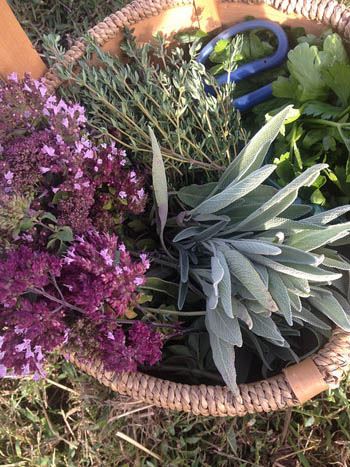Surprisingly, there were no weeds to harvest at the farm, so we focused on the tender crops. These are plants that react strongly to temperatures under 40F, like basil, tomatoes, and eggplant. And we made our last cutting of aromatic herbs for honeys and vinegars to get us through the long winter nights.

Cherry Tomatoes
We picked and picked and picked cherry tomatoes, knowing that frost will soon blacken them. Now how do we use all those cherry tomatoes? They don't last long. It is possible to eat a tremendous amount of them using this wonderful recipe for Slow Roasted Cherry Tomatoes. We are happy to eat roasted cherry tomatoes every single day, they are so delicious.

Pumpkins
We don't have to eat all the pumpkins we picked because they last a lot longer than the cherry tomatoes. The cheese pumpkin is a variety that is tastier than your usual bright orange pumpkin. I just pop the entire thing into the oven and bake it until soft. Once it is baked, it can become dinner or the basis of a tasty autumn soup.
Aromatic Herbs

As the days shorten, it is time to get outside and prune your aromatic herbs like oregano, rosemary, sage, and thyme. It is nice to dry some to have on hand for, but I find them much more useful when turned into remedies to use when winter brings chills, coughs, colds, and the flu.

Sage (Salvia officinalis)
I want plenty of "The Savior" on hand when winter winds blow. I cut the stalks and leaves finely and pack them into small jars, covering with honey or vinegar. When a cold or the flu threatens, a spoonful of sage honey in a cup of hot water is my first line of defense. Sage vinegar enlivens cooked greens and helps prevent flatulence when eaten with beans. One of my past apprentices swears it is the best underarm antiperspirant and deodorant she has ever used.

Thyme (Thymus vulgaris)
Tough little thyme is a star of oral health. I tinctured this bunch of thyme and will keep it in the bathroom next to my yarrow and bloodroot tinctures. With these girls on my side, I'll have healthy teeth for decades without toothpaste or commercial mouth wash. Thyme tincture tastes good too, and leaves the breath smelling fragrant. Thyme is also associated with a healthy heart. Thyme honey on whole wheat toast is a wonderful, fast breakfast.
Hardy Greens
Many people think that the herbs are all gone when the weather gets chilly, but many of them prefer to grow now. Let's see what we can harvest for salad. Daisy leaves, young yellow dock leaves, sheep sorrel, dandelion leaves and even a flower or two, ground ivy, garlic mustard, wild mustard, pepper grass, cheeses, wild madder, wild mints, including peppermint, spearmint, catnip, oregano, and monarda.

Daisy (Chrysathemum leucanthemum) leaves are one of my salad secrets. They have the most amazing flavor. A little goes a long way.

Yellow Dock (Rumex crispus) leaves are especially tasty in the early winter as the bitter principles move into the root. There is a flush of leaf growth as the days shorten that recommends itself to wintry salads.
Sheep Sorrel (Rumex acetosella) is yellow dock's baby sister. She is smaller and more sour, but a lot less bitter, so well worth the effort to seek her out and stoop down to harvest her whale-tail leaves.
Dandelion (Taraxacum off.) leaves are at their tastiest in October and November. Be sure to mince them into small pieces if you add them to your salads. (Bitters are good for the digestive system.) And don't forget to dig some dandelion root, too. Make vinegar or tincture it. Fall-dug root is said to be the best.

 Author: Susun S. Weed.
Author: Susun S. Weed. 









